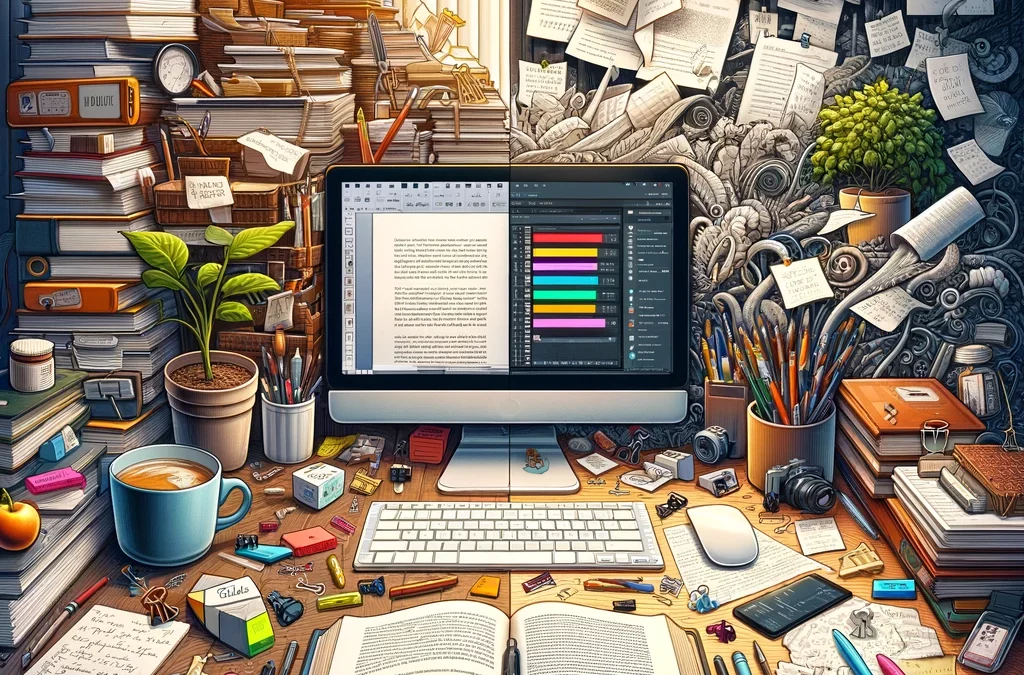
Dec 14, 2023
I have a natural inclination towards orderliness. I like everything to have its place and to put things away where they belong when I have finished with them. On my computer everything is neatly filed away in the correct folder and the desk where I write is arranged so that it doesn’t get cluttered. It gives me a sense of peace to work in an orderly environment.
For years, I have tried to write in an orderly manner, but I am coming to the conclusion that the process is inherently messy. Ideally, I want a system that I can follow each time, which should generate minimal debris. The way I have set that up is to plan stories using Goodnotes on my iPad, then using the plan I come up with there to write the first draft in Scrivener, to then export as a PDF, so I can do the edits on my iPad again and then type them up and the whole thing should be neat and easily contained.
That’s not how it works, though. Every time I try, I find myself compelled to get out pads of paper to make notes there rather than on my iPad. I jump back and forth between paper, Goodnotes and Obsidian.
It used to frustrate me, but I am coming to the conclusion that doing that isn’t a failure in my process, it is the process. Switching from one medium to another (even between two that are pretty much the same) is where the story comes alive. There is no way to systemize this process and there is no point looking for a single tool I can do everything in.
Planning a story is a messy process, I guess, and I just have to make my peace with the piles of paper that litter my desk. They aren’t a sign of failure, but of a system that has evolved naturally over the years.
Sep 18, 2023
I was born in 1983 and for more than half my life, reading books has meant paper. The first ebook reader I ever saw was in Waterstones book shop. It was one of the old Sony Reader ones, which means it can’t have been earlier than 2006 when they were released. Probably more like 2007. This was the first time I had seen an e-ink screen, and I was immediately interested. Unfortunately, I was a student at the time and the £500 that it would have cost to buy put it well outside of my price range.
The first ebook reader I owned was the Kindle Keyboard, which was the third-generation device, and the first at a price I could justify. Amazon released it in 2010, which means I would have been 27 years old when I started buying eBooks.
In the 13 years since I bought my first digital book, I have never not owned an eBook reader. Most of the time, that has been a Kindle, but I have also owned a Kobo and an Onyx Boox. They have always been e-ink devices.
I have bought paper books as well during that time, but reading that way no longer feels right. Although I love the aesthetics of a paper book, and I enjoy seeing them on my shelves, nothing can really beat the ease and convenience of reading an eBook.
Regardless of how many pages the book is, when it’s the eBook edition, it is comfortable to hold and read. I can carry around an epic fantasy novel with the same ease of a novella.
When I have tried going back to paper books (from time to time I get nostalgic for them) I have found I read much less. It’s difficult to hold a paper book open in one hand while stroking a cat. Paper books close themselves when putting them on the table to read while eating.
With a digital book, I can also read on my phone if I have forgotten to bring my eBook reader with me, or if I have been delayed unexpectedly somewhere. If I want to, I can buy the audiobook version as well and split my reading between audio and visual.
I have never been one to take notes in actual books. Something about writing in a book has always felt wrong to me. But I can do that with a digital book and not feel any sense of guilt. When I sync those notes and highlights up with a digital service like Obsidian, I can carry my book notes around wherever I am. As well as back them up, so I don’t have to worry about losing the book.
Last year I started wearing glasses for reading. With a digital book reader, I can adjust the size of the text so that I can still read myself to sleep without needing to wear them. That’s a convenience for me, but there are millions of people who need larger text books to read at all. With paper they are reliant on publishers putting out a large print edition, but with a digital reader they can make any book large print.
Digital books are not without their shortcomings. I have bought paper editions that feature illustrations, for example. But advances in color e-ink and increasing screen sizes of digital book readers are likely to eliminate those limitations in the next few years.
I also owe my career to digital books. While it’s now possible for independent creators to publish both paperback and hardback editions, it’s hard to imagine print-on-demand existing without the independent author movement being fueled by digital books.
I have nothing against paper books and expect to continue buying them from time to time. I will certainly continue publishing my own books on paper, because I love having a physical copy of them. But I love digital books most of all, and cannot foresee a time when they won’t be my primary reading method.

